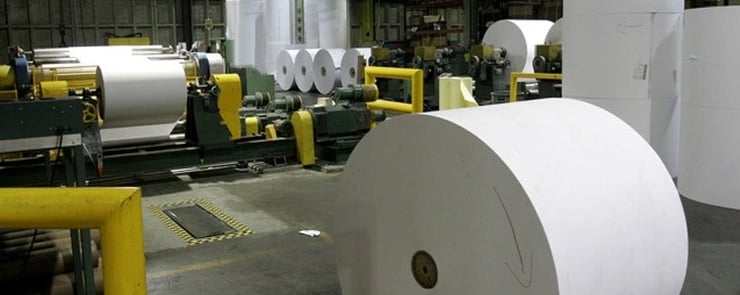
Operators at a Wisconsin paper mill were getting fed up with the self cleaning filters in charge of capturing fibers and large pieces of undissolved coating before being applied to paper stock. When the large particulates escaped the filters, they made their way to the production line, creating scratches in the paper stock, turning large rolls of paper into scrap.
No matter how many times they purged the DCF filters, they continued to let the large particulates through. Not only did they spend excessive amounts of time repairing and replacing prematurely wearing parts on the filters, they claimed to be losing 10-15% of the coatings they produced due to the frequency of purges.
Finally, they called Crane Engineering’s Rick Ogle and told him how the filters were performing. Ogle offered to come out to the facility to investigate the issue. Ogle quickly checked the self cleaning filters' current settings versus the preset settings. The preset settings for the filters had a purge cycle interval of 6 hours. The customer now had the purge cycle intervals set for much shorter time periods, one as short as .6 hours. It was clear that something was seriously wrong.
It didn’t take long to find the problem. Ogle opened each one and discovered that non-OEM parts were being used in the DCF filters.
Non-OEM parts often look the same and promote equal performance, to the original, but commonly have the following differences:
The first non-OEM part Ogle noticed was the drive nut being used to rebuild the cleaning disk assemblies. This is one of the most critical components of the assembly. If this component fails, the cleaning disk stops moving up and down, resulting in blinding of the filter element. This leads to high differential pressure, premature wear, and blow outs of the more expensive wedge wire elements.
The second non-OEM part discovered was the cleaning disk repair kit being used to rebuild the cleaning disk assemblies. It was clear the exact dimensions and materials of construction were not identical to the OEM parts. The original cleaning doctor material was specified based on coating materials used by the customer. The lower quality material being used in the non-OEM part resulted in premature wear of the doctors and insufficient cleaning of the wedge wire elements, also leading to blinded filter element, high differential pressure, and blow outs of the wedge wire element.
Ogle quickly put together an action plan to get the filters back to original performance. He recommended updating some controllers on the 17 year old filters, as well as updating the process flow information to make sure the filters in place were the right size for the application. He then recommended the customer change all the non-OEM parts out and replace with the original Eaton filter parts. Lastly, he recommended that operators and maintenance people receive refresher training on the filters to understand general operation best practices as well as general troubleshooting techniques.
With the correct parts in place, the mill is again producing high quality coating, and their purge settings have returned to normal levels, saving thousands per year on wasted coatings and product.
Headquarters and Service Center
Located outside Green Bay, WI
707 Ford Street
Kimberly, WI 54136
920-733-4425
OptiFlow Design and Build Center
1002 Truman Street
Kimberly, WI 54136
920-733-4425
Burnsville Service Center
12265 Nicollet Avenue
Burnsville, MN 55337
952-444-1949
Grand Rapids Service Center
26489 Industrial Blvd
Cohasset, MN 55721
952-444-1949
© Copyright 2024. Crane Engineering. All Rights Reserved. Privacy Policy.